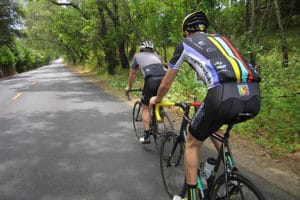Five Bad Riding Habits You Need to Break
 Richard Fries is the Director of Cycling Experience for the Best Buddies Challenges. With more than 40 years experience, he has been a racer, commuter, tourist, promoter, advocate, journalist and commentator on the sport and lifestyle of cycling. Having raced at the professional level both in America and Europe, Fries is well known as a race announcer having called countless USA Cycling National Championships, World Cups, and UCI World Championships. But he is also a tireless advocate having recently served as the executive director of MassBike. You can follow him on Strava to learn more.
Richard Fries is the Director of Cycling Experience for the Best Buddies Challenges. With more than 40 years experience, he has been a racer, commuter, tourist, promoter, advocate, journalist and commentator on the sport and lifestyle of cycling. Having raced at the professional level both in America and Europe, Fries is well known as a race announcer having called countless USA Cycling National Championships, World Cups, and UCI World Championships. But he is also a tireless advocate having recently served as the executive director of MassBike. You can follow him on Strava to learn more.
Now be honest, does your group ride have bad habits? Chances are the answer is yes. And, that’s okay because I’m going to tell you how to fix them.
Many weekly rides, even those with serious cyclists, can be poorly organized and focused far too much on busy people trying to squeeze too much “training” out of too little time. Novices typically end up all over the place. Place a beginner in that group and poor habits are made worse. But put that rider in with a solid, stable group and they’ll get it.
Here are some of classic bad habits that many novices need to correct if they wish to ride with a good club or simply improve their weekly group ride. Often riders with considerable experience and all the right gear will still have these bad habits.
Here are some bad habits to correct:
- Strong and Wrong. This is the most common problem. A hammerhead who has gained all sorts of fitness either riding alone or on a trainer destroys the “flow” of the group. (This guy articulates the ecstasy of finding Flow here: TED Talk on Flow, the Secret to Happiness) This rider constantly attacks the group on surges on the front, especially coming out of turns and from a dead stop. The biggest issue with such riders is because they are “strong and wrong” they falsely believe they should not have to listen to instruction. Ultimately a real pro will put them in their place and that outcome is often humiliation. How to Correct? Let the rider go off the front and ride alone or better yet, “feather” the rider, leaving him exposed in the wind but within reach of the stronger group. As the ride goes on that rider will pay a heavy price.
- Half Wheeling. This is when the front rider always rolls a half-wheel ahead of their partner. This is cruel and disruptive to the entire group. The purpose of riding 2×2 is to be a partner with the person next to you; if your partner is two feet up the road, you’re speaking to his or her back and he/she is shouter over his/her shoulder. Be a unit, be conversational. You’re both riding the same speed, so why not do it next to each other. How to correct? Simply put your hand on the middle of the rider’s back and adjust the speed yourself. If that does not fix it after three attempts, mention why you keep doing so.
- The Mailbag. This is a chronic problem. The desired goal is to have both columns riding so tightly together that each pair of riders can touch their inside pinky fingers. Far too many riders get nervous and adjust out to the left, feeling safer, but sticking out of the formation like a mailbag hanging out of a train. This leads to the misalignment and disintegration of the entire group. It’s also horribly rude to drivers trying to pass. How to Correct? Ask those riders to stay in the right column of the formation until they become comfortable there. Another trick for individuals is to constantly practice correcting to the right and not the left of the rider ahead.
- Swarming Intersections. The legendary Tim Johnson, my mentor on such things, says it best: “We ride in perfect formation for miles only to come to a red light and turn into a swarm of bees.” This is dangerous and discourteous to the cars, some of whom waited patiently to pass only to become swarmed at the light and forced to pass again. How to Correct? Whether you’re in the front of the group or the back, look up the road and anticipate traffic patterns. If you’re in the back, you shouldn’t swarm to the front at a stop light. Stay in formation. Explain this beforehand so that it doesn’t become an issue on the road. The entire group should simply refuse to tolerate behavior and teach the expectation at each intersection.
- The Cow and the Ostrich. Too often a novice rider will ride the wrong gear. Every rider should have roughly the same pedaling cadence. When in the group, note whether riders are in their large or small chainring (front gear) and where the chain is positioned on the rear cassette (that cluster of gears back there). Too small, or light, of a gear, and one will bounce around in the saddle and in the line, much like an ostrich. Too large, or heavy of a gear, and one will muscle the bike forward, pedaling like a cow, and then forced to freewheel. Both are inefficient to the individual and problematic to the group. How to Correct? Politely tell them to shift.



